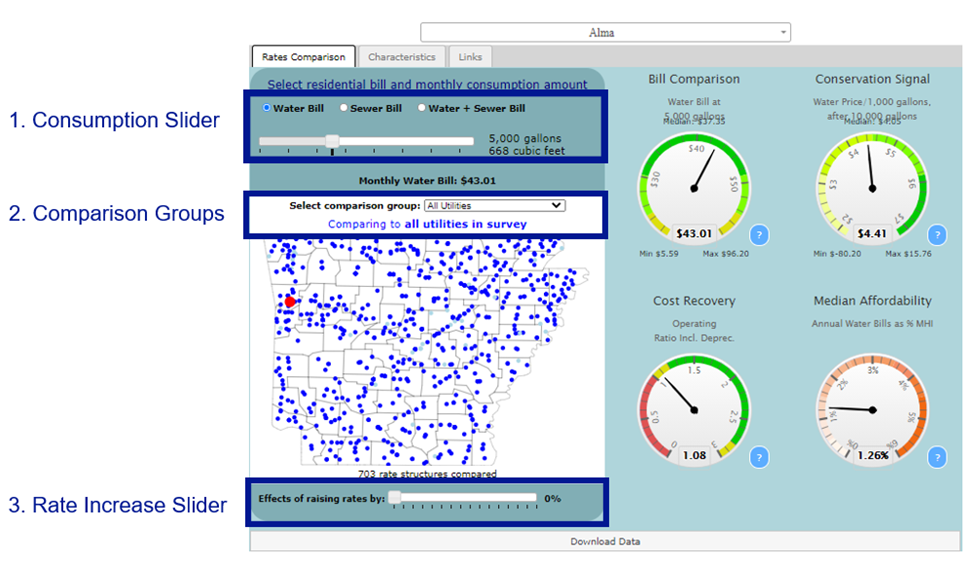Join us for a webinar on September 20th from 2:00 – 3:30 PM EST where we will demonstrate the 2021 Arkansas Water and Wastewater Rates Dashboard and answer your questions.
Click Here to Register
With funding from the US EPA and in partnership with Central Arkansas Water, the EFC deployed the 2021 Arkansas Water and Wastewater Rates Dashboard in August.
What can the rates dashboard do for you?
The rates dashboard provides an up-to-date look at rates for over 660 Arkansas utilities. Dashboards offer tools that can help utility managers and elected officials answer a few key questions relevant to their water or sewer utility.
Key Question 1: How do your utility’s rates compare to similar utilities?
Utility managers and elected officials often face political pressure to keep rates low. However, while it’s easiest to compare your rates to those who are geographically closest, it may not always be the best comparison, since other systems may be facing completely different challenges than your own. Use the dashboard’s “comparison group” dropdown to find utilities most similar to your own. You can select from among several categories. This will adjust the dial labeled “Bill Comparison,” and you can see how your rates at the selected bill amount and service compare to those with the similar selected characteristic.
Key Question 2: How effectively do your rates encourage conservation and sustainable water use?
Water is a finite resource. However, when it is very cheap, customers may pay less attention to how much water they are using. Many water utilities want to encourage sustainable water use among their customer base, and our “Conservation Signal” dial can help utilities achieve this goal. It shows how the price of water for the next 1,000 gallons after 10,000 gallons of monthly consumption compares to other utilities in the selected comparison group. The higher the price, the larger the price signal customers receive to conserve water.
The Arkansas Dashboard utilizes several variables to assess water and wastewater rates throughout the state.
Key Question 3: How financially sustainable is your utility?
Financial health is important to a utility’s ability to not only cover its day-to-day needs, but to cover future capital expenses as well. There is a lot of infrastructure involved in providing water and sewer services, and that infrastructure inevitably deteriorates over time. The “Cost Recovery” dial shows how well a utility’s revenues cover its current costs, including depreciation. A cost recovery of 1 means that costs equal revenues. However, because of inflation, infrastructure installed today will cost more to replace in the future because of rising material and labor costs. The EFC uses a cost recovery of 1.2 as a benchmark for a financially healthy utility because using only depreciation to guide reinvestment in infrastructure ignores inflation. Rate-setters can additionally use this information to inform customers about how utilities are financed, and to justify the necessity of rate increases for a financially viable utility.
Key Question 4: How affordable are your rates for customers on your water or sewer system?
It is eminently important that utilities charge affordable rates. Failure to do so may cause resentment and political pushback from customers. Our “Median Affordability” dial shows what a median-income household in the census location served by your utility would spend annually on water and/or wastewater, as a percentage of their income. This tool can help rate-setters gauge affordability as well as communicate with the public about rate affordability.
Key Question 5: How will the answers to all the above questions change if you raise your rates?
Curious about how a rate increase might affect your relative water prices, conservation signal, cost recovery, and affordability? Our rate increase slider can help. You can adjust this slider for estimates for each of the four dials. Note, however, that these estimates are based on certain assumptions, and that a more accurate estimate of the effects requires a rate study.
Want to learn more?
For a more detailed introduction to using the Arkansas Dashboard features, visit this guide: Anatomy of the AR Dashboard
Don’t see your rates on the dashboard or your rates are wrong?
If you find that your rates or financial information are missing or the data displayed is incorrect, you may send us your rates and/or most recent audited financial statement by email (efc@unc.edu) or fax: (919) 912-1927.
Free Technical Assistance for Small Systems
The EFC can provide free technical assistance on rate setting, financial benchmarking, capital planning, and affordability analysis to utilities with a service population fewer than 10,000 people. This work is funded by an EPA grant. If you would like to request assistance, please email efc@unc.edu or request direct assistance at the following link: https://efcnetwork.org/assistance/request-assistance/.




One Response to “Introducing the 2021 Arkansas Water and Wastewater Rates Dashboard”
Robert Pelt
Always seeking information